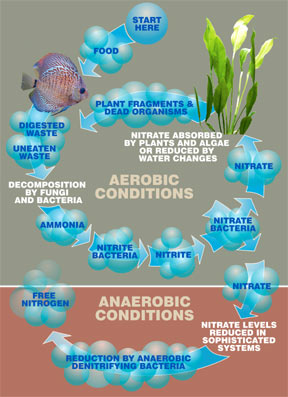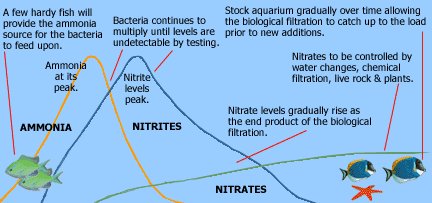
 Newly-set-up aquariums lack the colonies of bacteria that are necessary to perform the biological filtration. Because of this, the aquarium must be "cycled." "Cycling" refers to the process of establishing and maturing the biological filtration.
Newly-set-up aquariums lack the colonies of bacteria that are necessary to perform the biological filtration. Because of this, the aquarium must be "cycled." "Cycling" refers to the process of establishing and maturing the biological filtration.
In order to establish the system, we need to provide a source of ammonia for the Nitrosomonas bacteria in the filtration system so they can live, reproduce, and colonize. To provide an ammonia source, it is best to add a few hardy fish that can withstand the presence of ammonia and nitrites. Then we need to seed the aquarium with bacteria. There are commercially available cycling aids that contain the bacteria. Otherwise, when purchasing the hardy fish, request a small amount of gravel from the aquarium where the fish were held. This gravel should then be placed in the new aquarium along with the fish, and will provide the bacteria that are necessary to seed the system. Figure 2 illustrates the process that occurs in an aquarium during the biological filter maturing process.
As the fish in the new system are fed and begin to thrive, they will, through their biological activities, produce ammonia. The Nitrosomonas bacteria, in turn, will begin to feed upon that ammonia and will start populating the aquarium. Their population will be greatest in the media that contains the highest level of oxygen and surface area, which will normally be within the filtration system. At this point, because the numbers of bacteria are limited, they will not be able to convert all of the ammonia that is present in the system, so the ammonia levels will continue to rise. As the amount of ammonia increases, the population of bacteria will also increase, but at a much slower rate than the ammonia. The ammonia level will eventually reach a peak and then start to decline as the population of bacteria becomes large enough to break down the ammonia faster than it is being produced. During this "bloom" in bacterial population, aquarium water can take on a cloudy or smokey appearance. Because there is still ammonia within the system, however, the bacteria will continue to live and feed on the ammonia until it reaches a level undetectable by testing. At this point, the cloudy aquarium water will clear and a balance will be achieved where the rate of ammonia production equals the rate at which it is broken down by the bacteria. The number of bacteria, from this point on, will change as the levels of ammonia (their food source) changes.

As we can see in the illustration, the nitrites go through a very similar cycle as the ammonia. Nitrites are produced through the biological activities of the Nitrosomonas bacteria as they feed on the ammonia. As their numbers increase, so does the amount of their waste product, nitrites. The Nitrobacter bacteria, because of the increasing supply of nitrites, will multiply and increase in numbers. They, too, will be most densely populated in the area with the greatest surface area and oxygen content. The nitrite levels will rise until the number of bacteria has increased to the point at which they break down the nitrites faster than it is being produced. At this point, the peak level of nitrites has occurred, and the bacteria will continue to metabolize and feed upon the nitrites that are produced. The nitrite level will decrease until it becomes undetectable. As with the Nitrosomonas, the Nitrobacter will constantly alter their numbers as the amount of nitrites changes, keeping a balance at which the nitrites are undetectable.
The end product of this whole process is nitrate. Nitrates, in low to moderate concentrations, are not toxic to fish and invertebrates. Nitrates, however, can serve as a nutrient source for bacteria and plant life, and be the cause of other problems in the aquarium, such as excess algae. The anaerobic bacteria will break down the nitrates. Plants within the system will also feed on nitrates and are a good natural way of controlling this nutrient. Otherwise, the nitrate level needs to be controlled by chemical filtration and partial water changes.
The length of time required for this cycle to be completed in the new aquarium depends on many factors. These factors include:
- The amount of ammonia being produced during the cycling period
- The efficiency of the biological filtration
- Whether live rock or live plants are used in this process
The typical time period in most aquariums is going to be 3 to 6 weeks. It is important that if any of the fish used during this process perish, that they be replaced with another hardy fish in order to maintain the input of ammonia.
[
Part 1 |
Part 2 |
Part 3 |
Part 4 ] |